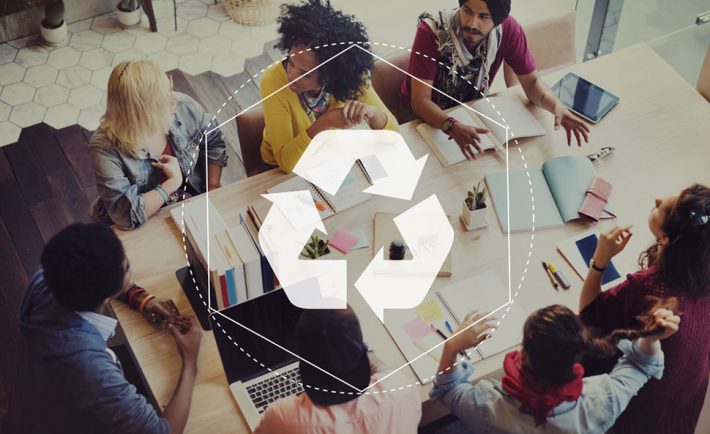What if you tried to make your business more sustainable and responsible? Odds are your organization will become more efficient and reduce costs, while boosting employee motivation. We have 20 ideas to help you get started.
Sustainable Offices, Eco-Friendly Businessses and Green Employees
Nowadays, the number of organizations not focusing on CSR, not caring about being responsible towards their stakeholders, not investing in green actions or in becoming more sustainable is increasingly lower. But to be truly sucessful, this must be a two-ways process.
Indeed, we spend a good part of our life at our companies. As such, a large part of our impact on the environment happens during our time at work. Hence the need to make daily work choices that help us correctly participate in the transition towards a fairer and more responsible world.
The problem is that it is not necessarily clear how one can be a responsible employer or employee. People don’t always have the time to think about it, nor the energy to reflect about their everyday actions and environmental impacts. Luckily, by following a few simple steps, we can already do a lot to improve our carbon footprint and ecological impact, as well as our well-being at work. Below are 20 easily-implementable steps (divided into 4 categories) that will help your business and yourself as an employee act more sustainably.
Actions To Reduce Waste

1 – Recycle Your Office Waste
All the good recycling habits that we have at home, we often forget when we are at the office. A simple step to becoming a more sustainable employee is, therefore, to take action against this (absent) habit. As an employer, make sure you have recycling bins well spread and identified and that your employees are aware of the recycling rules within you municipality.
2 – Avoid Plastic Cups and Other Disposable Cutlery
Using a plasic or even a plastic-cardboard cup may seem like a small gesture but altogether, it can have a significant environmental impact. There are about 220 working days in a year. Imagine you take 2 coffees per day: that represents almost 500 cups and 500 stirrers discarded unnecessarily each year.
Imagine how much waste would be avoided if every employee switched from a disposable to a reusable cup. In case you’re wondering about the initial cost of such transition, worry not – the investment quickly pays for itself. The same goes for cutlery and disposable crockery.
3 – The Impact of Your Lunch – Be Rational
We often don’t realise it, but when lunch time comes, a lot of waste is created. If you have a canteen, don’t take 3 pieces of bread when the odds are you’ll only eat one. Also, serve yourself (or ask, if that’s the case) for a smaller portion if you’re not that hungry.
If you have your meals delivered, consider doing group orders. Indeed, if you are in an open space with 20 people and each one orders from different places, this multiplies not only the number of containers and packaging bags, but also the delivery journeys. Plus, do you really need that plastic water bottle, even if it’s part of the menu, when you have a water filter at the office?
Finally, if you usually prepare your own lunches, do not throw away your leftovers, save them for the evening – there are plenty of ways to cook leftovers in delicious ways! And what about using those vegetable peels for some soup or freezing them and using them to make a broth later? Think about it!
4 – Measure Your Waste Impact
When we’re at the office, as it is nor really a space under our responsibility, it is often easier to lose track of the waste we produce. But among printed papers, coffee pods, water bottles, single-use cups, office supplies or paper napkins used excessively to dry our hands: we’re reponsible for creating a lot of waste.
To gain more clarity here and to motivate yourself to act, try measuring your waste impact. For example, as an employer, you can weigh the waste that your open space or your offices produce in 1 week, or ask a service provider to do it for you. And then, with this specific data to work with, it becomes possible to establish goals, indicators and to work on those metrics so that less waste gets produced.
5 – Organize “Waste Reduction” Challenges
You can also reduce your waste in a fun way using to challenges. Who will print the least in June? Which team will produce the least waste? Who’s in charge of monitoring and producing progress reports? This is an interesting way to get teams together while pushing for more sustainable behaviors.
Reduce the Environmental Impact and Save Energy and Resources

6 – Think About Insulation
The heating of business premises is the first item of energy expenditure in the private sector. Each year, companies consume 55,000 gWh of electricity (Switzerland’s annual consumption), or around 28 million tonnes of CO2. Insulating your facilities is, therefore, crucial to reduce the office’s energy bill.
If your business can afford it, try to get your managers to do insulation works done according to thermal regulations. But in your daily life, think about it too! Do not open the doors or the windows when the air conditioning / heating is on, close the shutters during the evening period to avoid losing heat…
Related: CSR Strategy: The 9 Benefits Of Business Buildings With Vertical Green Walls
7 – Think About Energy Efficient and Anti-Waste Eco-Gestures
In the same way, think about eco-friendly actions you can take. Like turning off the lights when you get out of the toilet, for example. Or adapting your heating to the outside temperature (if the weather is good, there is no need for heating).
Turning off your computer when you go on a lunch break is relevant too. Not printing documents unless it really is necessarily, together with… There are simple and apparently not very significant actions, but it everyone had them in mind: environmental impacts would be greatly reduced.
8 – Use Big Data, Home Automation, and Configure Your Equipments
If these eco-friendly actions really seem complicated to you, beware that big data can help you do a good job here. There are now automatic switch systems for lightning, heaters with thermostats which adapt automatically or home automation systems which reduce unnecessary consumption.
You can also set up your equipments correctly without using these smart gadgets. For instance, you can instal a software to put your screen in standby mode after a certain period without activity. Or you can decrease the screen’s brightness or even get your laptop in energy saving mode if you are not using all its power…
9 – Adapt Your Dress Code
To avoid wasting energy, adapt your outfit and ask your management to be more flexible on the dress code. Wearing a suit with shirt, a jacket and a tie during a heatwave – it’s not pleasant, nor is it very sustainable and eco-friendly since it likely means turning on the AC. So if possible – when there are no representation constraints – adopt a climate-adapted dress code.
10 – Invest In Eco-Designed Equipment
If you have the choice, choose eco-designed equipment. Get laptops and screens with A+ energy certificated, which consume less energy. Switch to LED lights which are way more efficient. Buy paper certified as coming from responsibly managed forests or recycled. In short… choose greener materials and gadgets.
11 – Learn How To Use Your Digital Tools Correctly
When it comes to energy saving, we don’t think much about digital tools. Still, there are some best practices you can take to use your computer properly. For example, stop copying your emails to all your colleagues when it actually brings no value to anyone. Remove that large picture from your signature – it is useless and it overloads your emails. When you know that each email can emit up to 50g of CO2 when adding large attachments, you realize this is not meaningless. Keep in mind that 50 g of CO2 is almost 1 km by car.
Pro tip here: use the carbonalyser browser extension to figure out what are the CO2 emissions related to your digital use. Your emissions will be presented under the equivalent of number of charged smartphones or km traveled by car.
Choose Greener Consumption and Working Methods

11 – Consider Vegetarian Meals
At lunch break, consider adopting a more ecological diet. For example, setting aside at least one day in the week for a vegetarian lunch is already a good way to reduce your environmental footprint. When we know that a kilo of meat is equivalent to 15 to 40 kg of CO2, it makes you think… Besides that, rice or lentils represent only 1 to 3 kg of CO2 per kg of food. So adapting and choosing a vegetarian diet whenever you can matters. Mind the high ecological and social impact of avocados though!
12 – Do Your Part In the Circular Economy
Can’t see the connection to your work? Yet there is one! The circular economy is the idea that we must refuse, repair, reuse and recycle what would otherwise become direcly waste. So whether it is some electrical equipment, your batteries, bulbs, office supplies, plastic bottles and cups… Some things can be fixed: do it instead of purchasing new gadgets and contributing to deforestation.
Ultimately, there is surely a better exit and end of life cycle for office materials or gadgets. From fixing and repairing, to reusing them (even if for a different purpose) or offering them for artistic purposes. Mind your waste: it may not really need to become waste.
13 – Organic, Local and/or Seasonal Products Delivered At the Office
Have you thought about having baskets of organic and seasonal fruits and vegetables delivered to you (via group orders, of course) at the office? Whether it’s to take home or eat as a healthy snack at work, this is an idea which can suport local and seasonal food producers.
14 – Discover and Support Alternative Mobility Options
Carpooling, cycling, electric bicycles, scooters, even walking… There are dozens of alternative mobility methods that can replace cars and their heavy CO2 emissions. How about a who-pollutes-less-to-get-to-work competition?
15 – Use Digitalization
Finally, in your work, think about digitalization! The idea? Replacing paper and traveling with online work to avoid wasting time, energy and resources. But beware, the environmental impact of the internet is not zero! So, be vigilant and be digital… but not too much!
Improving Well-being At Work and Living Together

16 – Telecommuting: It’s Green and Better For You
We cannot repeat it enough, but teleworking is good! And with the current coronavirus situation, it is all the more recommended to reduce health risks. When possible, it avoids moving around (and therefore polluting), it saves time, and it allows you to better manage your private life. It needs to be balanced with employee socialization needs, but it surely brings many personal-life benefits.
17 – Develop Flexible Schedules
In many companies, there are still misconceptions about working hours. The most deserving would be those who stay as long as possible at work. The problem is, all the studies indicate that those staying the longest in the office are usually less productive.
Indeed, shorter working days or more flexible schedules allow employees to be more productive, more motivated, and to be better in their professional life.
18 – Take Lunch Breaks Together With Your Colleagues
Being a responsible company also means thinking about a good atmosphere at work. And what better way to unwind and get to know your colleagues better than having lunch together? Take the time, once a week, to set aside a day for these moments of living together. In these times of physical distancing, doing so virtual can also be important. How about a virtual beer this Friday at 5?
19 – Try Team-Building Events
Sports at the workplace? Team building events? Skill-based sponsorships? There are dozens of tips for tightening working teams. Learn more and get started!
20 – Spend Time With Your Colleagues Outside of Work
Finally, a last idea to improve living together in your company is to see your colleagues outside of work. Having a drink from time to time, organizing Christmas or company anniversary parties or playing sports together are all ways to create stronger team bonds.
[Photo by Arlington Research on Unsplash]

